MHC Class I & II Tetramers
Our MHC Tetramers enable MHC Class I and Class II detection of antigen-specific T cells
T-cell receptors (TCRs) are found on T-cell surfaces. They recognize and bind to MHC molecule complex bound with specific peptide sequences expressed on the surface of antigen-presenting cells. These MHC complexes bind with peptides that were formed from cytosolic protein degradation. MHC complexes are divided into Class I and Class II, where CD 8+ T-cells recognize Class I MHC molecules and CD 4+ T-cells recognize Class II MHC molecules.
MBL International provides high quality MHC Tetramers for targeted detection of specific MHC/peptide complexes. MHC/peptide monomers are biotinylated and tetramerized with streptavidin to maintain stable binding to multiple TCR, enabling MHC/peptide tetramers to be used as detection tools. MBL International offers MHC tetramers for various Class I Human, Mouse, Rhesus Macaque, Mauritian Cyno, Chicken and Human-Mouse chimera alleles. Also offered are various Class II Human and Mouse alleles, as well as CD1d and MR1 tetramers. Phycoerythrin (PE), allophycocyanin (APC), or Brilliant Violet™ 421 (BV421) fluorophores are available for detection of antigen-specific T cells by flow cytometry or fluorescence microscopy using our MHC multimers.
MHC tetramer technology is based on the ability of MHC-peptide complexes to recognize the antigen-specific T cells at a single cell level. This breakthrough technology enables researchers to precisely measure targeted T-cell responses in infectious diseases, cancer, and autoimmune diseases.
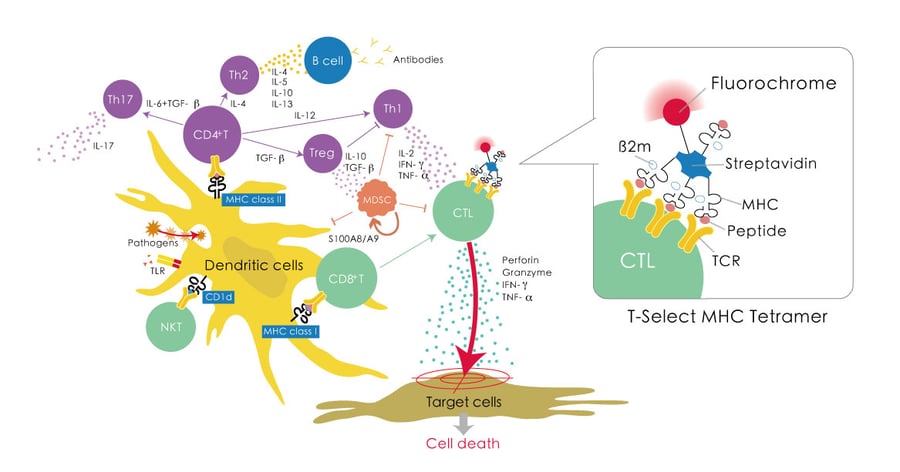
- MBLI tetramers offer Superior Specificity with α3 Mutation*
- Class I and Class II Available
- PE, APC and BV421 Conjugates Available
- QuickSwitch™ Create your own custom Class I and Class II MHC tetramers
- Available MHC Alleles
- Custom Services Available
*Only human and macaque HLA Class I Tetramers contain the alpha 3 mutation.
Tetramer Staining Protocol and Tips
Download our free Tetramer Staining Guide to learn how to stain human or mouse T cells with MHC Tetramers. Gain some helpful tips and tricks for successful T cell staining. Learn how to set up experiments, analyze results, troubleshooting, and more!
Advantages over competitors
Our MHC tetramers show a higher performance in specificity and target separation when comparing to MHC Multimers
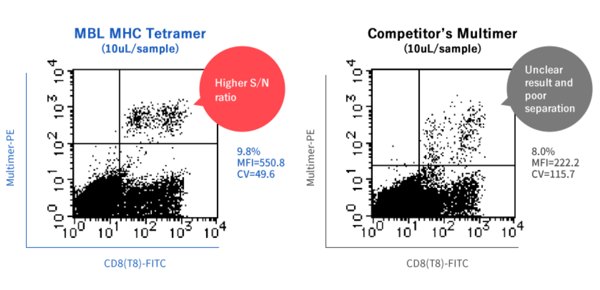 MBLI MHC Tetramer vs MHC Multimer
MBLI MHC Tetramer vs MHC Multimer
Comparison with competitors (MHC Class I)
| MBL MHC CLASS I TETRAMER | COMPETITOR’S MULTIMER | |
|---|---|---|
|
Reactivity
|
Our MHC tetramers show high specificity due to a patented mutation (alanine to valine at position 245) in the MHC class I heavy chain, which reduces undesirable CD8-MHC interaction.
|
No comments regarding reactivity of competitor’s multimers.
|
|
Quality
|
Optimized mixing ratio of raw materials dramatically improves tetramer synthesis efficiency and achieves high sensitivity.
|
Competitor’s multimers sometimes show low reproducibility due to difficulties in quality and quantity control of the number of MHC molecules when producing multimers.
|
|
Stability
|
Can be stored at 4°C in refrigerated form for several months and is ready-to-use.
|
Storage stability is equivalent to MBL MHC tetramers.
|
|
Custom MHC Tetramer
|
Availability of more than 60 types of MHC alleles.
|
Only 20-30 types of alleles.
|
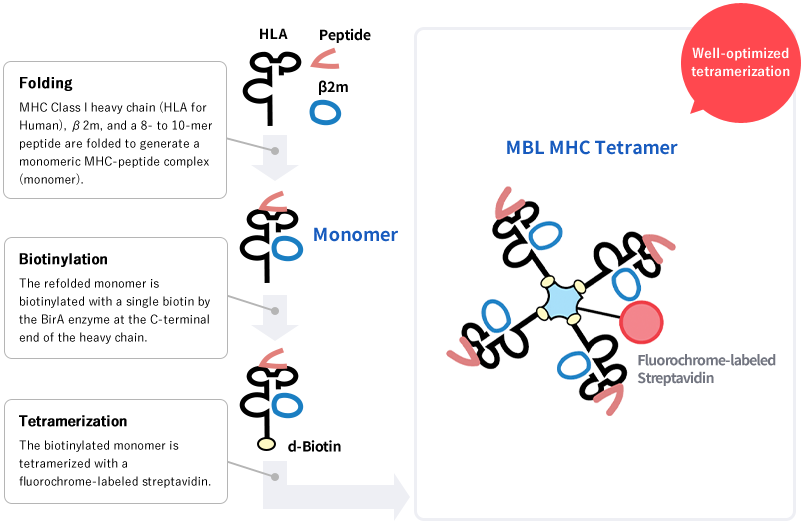
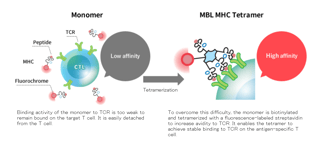
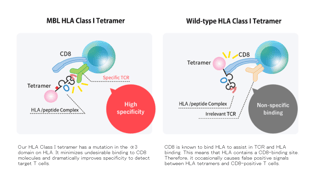
Create your own custom MHC tetramers with QuickSwitch™
Create high quality custom human Class I and Class II MHC tetramers and mouse Class I MHC tetramers in your own lab using our unique QuickSwitch™ tetramer kit. Create new specificity tetramers in just a few hours with QuickSwitch™, a proprietary technology where peptides are easily exchanged on MHC tetramers. Use this kit for screening peptide-MHC affinities, make your own MHC tetramers, and many other applications. Multiple alleles are offered, and new alleles are continuously being added to our QuickSwitch™ kit offerings.
Allele Frequencies
It is important to know which alleles are most common. Use this database to find the frequency for your allele of interest.
Allele frequency net database (AFND) 2020 update: gold-standard data classification, open access genotype data and new query tools. Gonzalez-Galarza FF, McCabe A, Santos EJ, Jones J, Takeshita LY, Ortega-Rivera ND, Del Cid-Pavon GM, Ramsbottom K, Ghattaoraya GS, Alfirevic A, Middleton D and Jones AR Nucleic Acid Research 2020, 48, D783-8.
Databases for epitope predictions
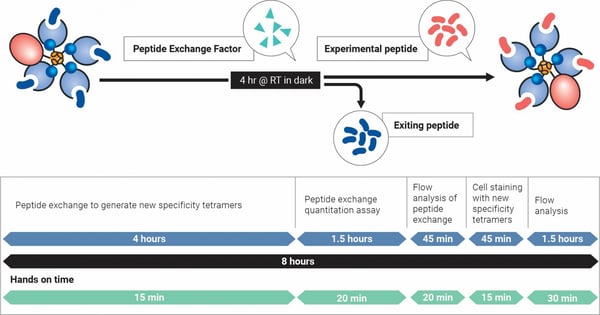
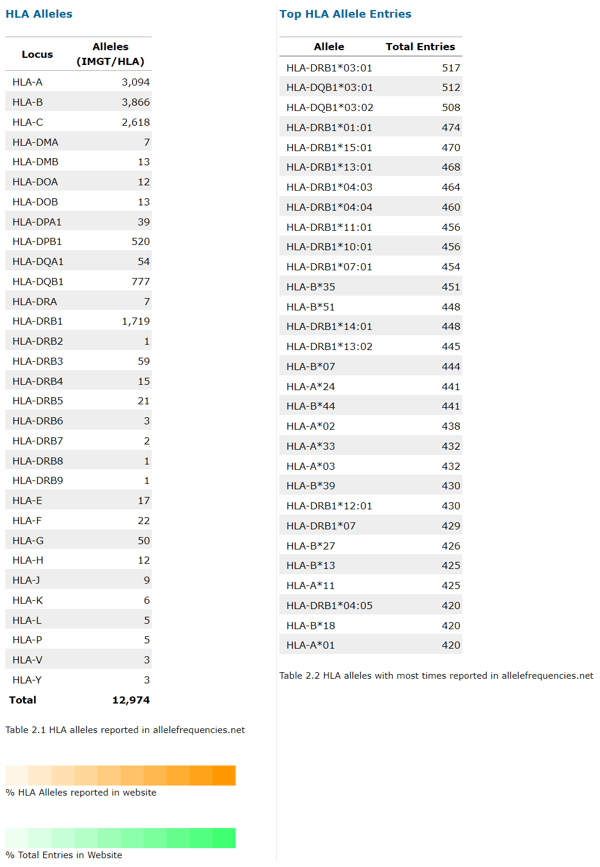
Learn about the types of MHC Molecules
Tetramers
TCRs recognize and bind to complexes composed of MHC molecules and specific peptides expressed on the surface of antigen-presenting cells.
Monomers
Biotinylated MHC monomers, the building blocks of MHC tetramers, are now available for tetramer construction flexibility and novel applications. MBL International offers MHC Monomers for many different Class I and Class II alleles.
Class I
T cell receptors (TCRs) expressed on the surface of T cells specifically recognize and bind to complexes of major histocompatibility complex (MHC) molecules and peptide fragments.
Class II
T cell receptors (TCRs) expressed on the surface of T cells specifically recognize and bind to complexes of major histocompatibility complex (MHC) molecules and peptide fragments.
CD1d
CD1d molecules are non-polymorphic MHC class I-like proteins. These are a type of non-classical MHCs. They present phospholipid and glycosphingolipid antigens to invariant Natural Killer T (iNKT) cells, a subset of CD1d-restricted T cells.
Non-Classical
Non-classical Major Histocompatibility Complex (MHC) molecules are non-polymorphic proteins that are implicated in both the innate and adaptive immune response.
MR1
Lorem ipsum dolor sit amet, consectetur adipiscing elit. Praesent lobortis arcu sit amet elit tempor, sit amet convallis augue vehicula. In eu cursus tellus
TCR Tetramers
MBL has developed and manufactured various major histocompatibility complex (MHC) Tetramer products as tools for detecting antigen-specific T cells. These products have been used to monitor T cell immune responses in research studies and clinical trials.
QuickSwitch™
Rapid, high-quality creation of custom Class I and Class II MHC tetramers in your own lab is now a reality! Create new specificity tetramers in just a few hours with QuickSwitch™, a proprietary technology for exchanging peptides on an MHC tetramer.
SARS-CoV-2 Bundles
Analyze antigen specific CD8+ T cell responses to SARS-CoV-2 quickly and easily with the MHC class I QuickSwitch™ kits bundled with SARS-CoV-2 peptides.
Tetramers Citations
MBL International is renowned in the life sciences industries for high quality and trusted reagents. We are proud to highlight ground breaking research. Find peer reviewed publications/citations for MBL products below.
Immune Monitoring FAQ
Lorem ipsum dolor sit amet, consectetur adipiscing elit. Praesent lobortis arcu sit amet elit tempor, sit amet convallis augue vehicula. In eu cursus tellus
QuickSwitch™ FAQs
FAQs – QuickSwitch™ for MHC-peptide exchange
Find important tetramer documents below:
Tetramer Allele List
Lorem ipsum dolor sit amet, consectetur adipiscing elit. Praesent lobortis arcu sit amet elit tempor, sit amet convallis augue vehicula. In eu cursus tellus
Custom Order Form
We can help with your specific requirements for immune monitoring needs. MBL International has a long line of expertise and knowledge for manufacturing MHC tetramers and monomers
Request Our Tetramer Staining Guide
MBL International's new Tetramer Staining Guide is a collection of protocols and data to help make your experiments a success.
Terms and Conditions
Explore our video library of webinars
Download our free webinars which focus on different life science research topics and applications. All webinars are presented by our scientists at MBL International.